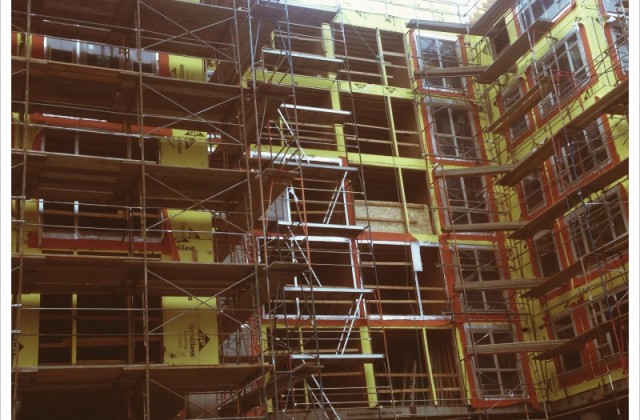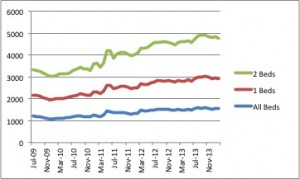The Rents They Are a Changing
The politics of housing in Seattle are all about prices, especially monthly rents. One side of the debate argues that if we create more housing options and choices in housing location and type, we’d get better places to live and stable or lowered prices. The other side of the argument holds that when we build more housing, prices actually go up because developers want to build housing for rich people and because we knock down existing cheap housing. This second view has been taken on by both social equity advocates and no-growth advocates who argue the City should increase rules and regulations on new housing or stop new housing all together.
Central to the discussion is whether or not rents actually do go down if we allow more housing. I’ve written numerous times that it is simply a fact that rents adjust themselves based on inventory; when there is excess supply landlords compete with each other and they lower rents. On the other hand, when demand starts to outpace supply, prices go up as renters have to compete with one another for scarce housing options.
What does the Internet say about all this? Well here’s the latest from the consumer focused RentJungle.com that touts itself as The Housing Search Engine:
The average apartment rent over the prior 6 months [since February of this year] in Seattle has decreased by $45 (-3%) One bedroom units have decreased by $10.5 (-1%) and two bedroom apartments have decreased by $27 (-1%)
Yes, you’re reading that right, average rents have been going down over the last 6 months. Rents do that. They actually do go down. It’s hard to say what accounts for this shorter term decrease. But the point is that rents do change, increasing and decreasing based on market pressures from demand and lagging supply.
| Month | All Beds | 1 Beds | 2 Bed |
| Sep-13 | $1,575 | $1,415 | $1,902 |
| Oct-13 | $1,594 | $1,421 | $1,906 |
| Nov-13 | $1,574 | $1,396 | $1,880 |
| Dec-13 | $1,534 | $1,374 | $1,876 |
| Jan-14 | $1,555 | $1,379 | $1,897 |
| Feb-14 | $1,540 | $1,381 | $1,846 |
| Decrease | $(35.00) | $(34.00) | $(56.00) |
Rents also go up. Between 2009 and 2014 the average rents have increased about 20 percent, and year over year they have been going up between 4 and 5 percent per years, faster than inflation. Inflation has been ranging between negative percentages in 2009 (-2.6 percent) to very low rates so far this year (about 1.5 percent).
But have rents been affordable? Well, based on the only measure of affordability we have, the normative standard used by the Department of Housing and Urban Development (HUD), that answer is, for people who earn more money, yes. For example, in 2011, a year with a big month-to-month increase in rents (14 percent from April to May), the average rent for a one bedroom was $1,130. The HUD standard of affordability for a person earning 60 percent of Area Median Income is 35* percent of monthly income or, in 2011 dollars, $1,140 with utilities included.
It seems that people at these higher levels of income, 60 to 80 percent, make up the “rents are too high” indicator on local political dashboards. When prices start to edge up for people earning 100 percent of median income or close to it, the phrase “the rent is too damn high” gets said more often and louder. For this income level, often more mobile and affluent than poor people earning less, the aggravation of trying to find a place to live increases to levels experienced routinely by the poor. Instead of that two bedroom with a washer and dryer, a couple has to settle for a one bedroom and the search for what they did find, went longer than expected.
I don’t want to diminish this real pain. People are forced to make choices between things they want, things they need, and their financial future. An extra $100 a month is $1200 per year that could be saved, for example, for the purchase of a house or for day care or some other necessity. Having to choose a less expensive apartment might actually put someone two transfers away from work instead of one. But for people earning from 60 to 80 percent of AMI, these are challenges that can be overcome, especially if we build more housing. Poor people on the other hand face the problem of paying rent, day care, other bills, and possibly eviction.
But this is hardly a social justice or equity issue for people earning 60 to 80 percent of AMI; it is more a question of marginal utility or disutility. And what happens in Seattle politics is that just as the pain being expressed by people at these levels of income becomes the loudest, the City Council’s temptation to make more rules and “crack down” on greedy developers becomes the greatest. We start to hear “even nurses, teachers, construction workers and many other middle-wage workers”struggle to find housing. The the argument is that we should tax new growth to subsidize people at these income levels, even though poor people face the bigger housing problem.
But doing things to make it harder to build more housing when rents go up is exactly the wrong thing at the wrong time – the City Council should respond by relaxing rules, taxes, and regulations not thinking up new ones.
We will continue to press this point: when the rent feels too high, and people at higher levels of income start complaining is exactly the time to build more housing of all types in all neighborhoods for all levels of income. When we don’t do that poor people suffer even more, because, for them, smaller increases in price are even more devastating to their residual incomes and more affluent people end up occupying cheaper units longer that might become vacant if they had more options. Imposing rules, regulations, and taxes on new housing in the name of helping the poor or in the name of equity makes life worse for everyone at all levels of income, especially people who are poor who have to spend a greater percentage of their income on rent.
* A commenter questioned the math here. The HUD standard always includes an allowance for utilities. It doesn’t adjust for taxes or other residual costs. It’s why it is a terrible measure. You can read why I don’t like it and why I propose an alternative here



